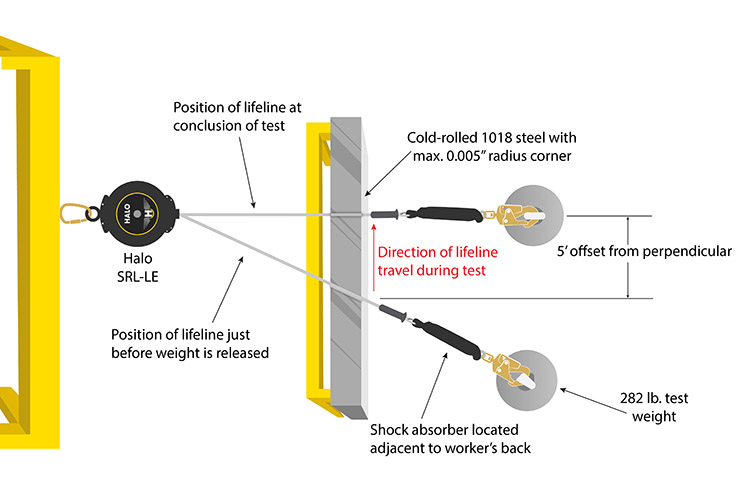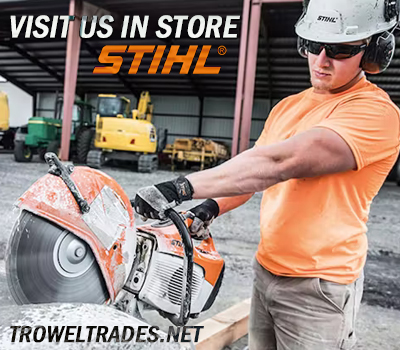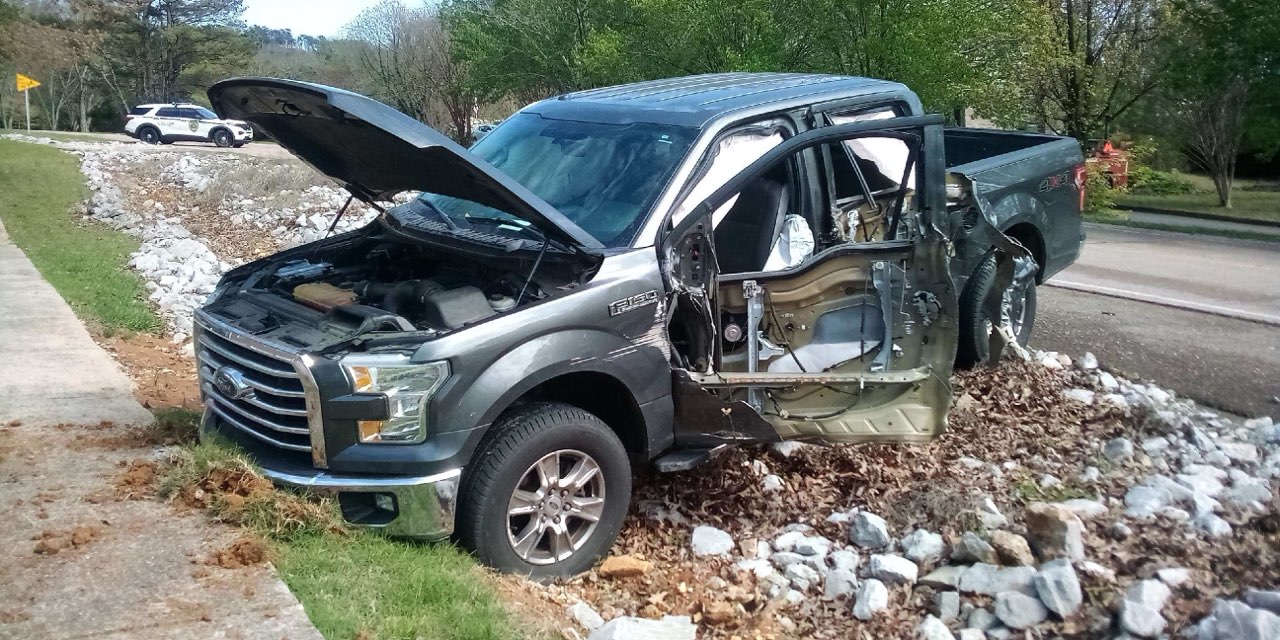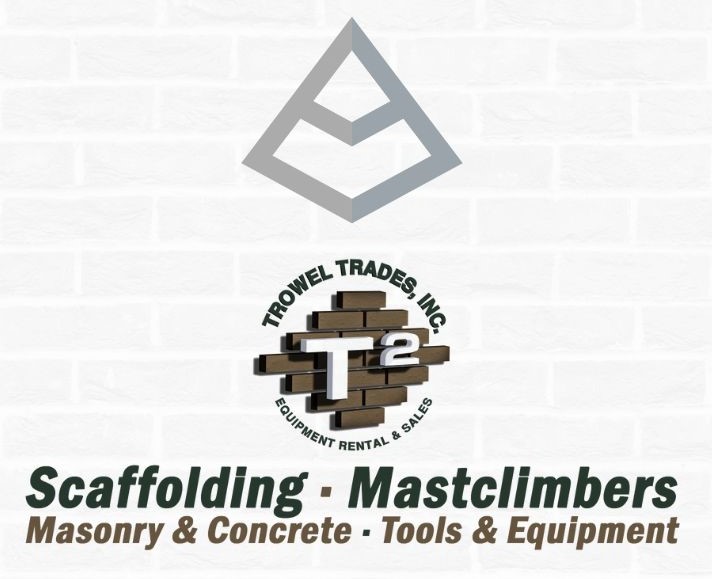
FREE SHIPPING ON
ALL QUALIFYING ORDERS
Enter your email below to join our mailing list:

REFLECTING REALITY – THE OFFSET DROP TEST
We can’t know how a fall protection product will perform, of course, until we do extensive testing in our lab. Testing is the place where the rubber meets the road, and where the eyes of anxious product engineers are glued to find out whether their designs will work, whether they must, literally, go back to the drawing board and tweak things, or in some cases, start all over. The goal of extensive testing is to ensure that when a product is called to duty, is answers the call with flying colors.
THE SET UP
ANSI testing procedures mimic, as closely as possible, the real-life situations in which fall protection equipment is used, and help guide manufacturers to define the methods of use and expected performance of the equipment they make. As we know, fall protection equipment, even a single device such as an SRL (which will be our focus here), is a system. It is a combination of individual parts that work together to perform a job. Even if the component parts of an SRL are tested individually, that is no guarantee that they will perform as expected once the SRL is assembled.
One of the most demanding tests ANSI requires is called the dynamic “offset” drop test of a SRL-LE. Due the fact the lifeline component of an SRL-LE may contact an unfinished (or sharp) edge during a fall, ANSI requires a stepped-up test to ensure the lifeline maintains its integrity in such instances. The dynamic offset drop test is really a combination of three tests in one. In a standard dynamic drop test, a 282 lb. weight is dropped with no interference on the lifeline to measure arrest distance and maximum arrest force. In a SRL-LE drop test, the same dropped test weight is allowed to fall below the level of an ANSI-specified edge of 1018 steel with a radius of no greater than .005”, which forces the lifeline to bend over the sharp edge under tension. The intent here is to simulate a worker falling over the edge of the structure they are working on, and the lifeline contacting that structure, which puts greater strain and abrasion on the lifeline, potentially weakening it. That .005” radius isn’t arbitrary, by the way, it is based on the dimension of common structural steel. The offset drop test combines these two tests, and adds yet another torturous dimension.
The setup for an offset drop test is similar to the standard SRL-LE dynamic test, but instead of the SRL’s lifeline being perpendicular to the edge it will go over, it is offset by 5 feet. Meaning that when the test weight is dropped, the lifeline will hit the steel edge at an angle, then slide its way back to perpendicular as the weight continues to swing. This will create a sort of “sawing” effect, in which the steel edge will dig into the lifeline, compromising (to some degree) its integrity and strength. In a very real way, this test replicates nearly all leading-edge falls because the likelihood that a worker falls with their lifeline exactly perpendicular to the edge is very low. And in fact, even if they did, the motion of the worker’s swinging would cause a similar sawing action as they regained their composure and were able to stabilize themselves.

STRING THEORY
This test again draws our attention to the critical factor in a leading edge test – the lifeline. Remember, when a fall occurs, forces are generated by the worker, through the harness, and then travel along the lifeline back toward the anchor. When these forces are interrupted by the lifeline contacting an edge or other material, they are focused at the point of impact and potentially load the lifeline beyond its ultimate strength, causing a failure. This is why ANSI Z359.14 specifies that all leading-edge compatible self-retracting lifelines must, “…include an integral energy absorber element adjacent to the ends of the line which connects to the body support.” The purpose of the absorber being located on the “down” side of the fall with the worker is to shed the fall forces and prevent them from focusing on the contact point of the lifeline and edge. Adding the offset component to the test doubly stresses the lifeline by imparting extra physical damage to the lifeline as it slides across the edge, stressing it (and the engineer’s nerves) to the limits.
KEEP IT BETWEEN THE LINES
Product testing can be a tricky business. As hard as safety engineers and manufacturers work to devise methods to ensure products can withstand the abuse they take day in and day out, there are unfortunate instances when a worker is injured on the job. In the vast majority of cases, these injuries occur when the worker used the product in a manner inconsistent with the manufacturer’s instructions. Keep this in mind: the specific instructions for fall protection products are derived directly from the results of testing. Manufacturers define usage parameters based on their ability to test the product in circumstances similar to those parameters, as in the case of the offset leading edge test above. These are not merely suggestions, rather, they are directives intended to prevent you from using a piece of equipment outside of its design specifications. So the next time you get a new piece of fall protection equipment, read the instructions thoroughly and think about the testing that was done to ensure the equipment will perform as you expect it to. If it’s an SRL-LE, think about the offset drop test, the lifeline grating across the steel, and the test weight still hanging safely below because a group of engineers did their job well. Then, get to work – and be safe up there.





No spam, notifications only about products and updates.

Having dealt with MK Diamond Products and the Delahauts since the mid 1990’s it is sad to hear the news that they have closed their

I’ve told my wife and daughter to never follow a mortar mixer down the interstate. For over 30 years we have sold, rented, and repaired

This question is one of the most frequent mixer related questions our rental staff are asked. Our contractor customers know the importance of using the right tools for the job.

Trowel Trades, a company that specializes in equipment rental, tool retail, repair services, scaffolding and mast climber access solutions, enters the Silver Tier of the Masonry Alliance Program.
Your email was submitted successfully.
YOUR 10% OFF COUPON CODE IS WELCOME10.
See category exclusions below.
Category Exclusions:
Arbortech Brick and Mortar Saw, Compaction, Concrete Mixers, Concrete Walk Behind Saws, Drop Hammers, Grout Hogs, iQ Power Tools, Masonry Block Saws, Masonry Brick Saws, Mast Climbers, Mortar Mixers, Mud Buggy, Saws, Scaffold, Self Dumping Hoppers, Shoring, and Stihl